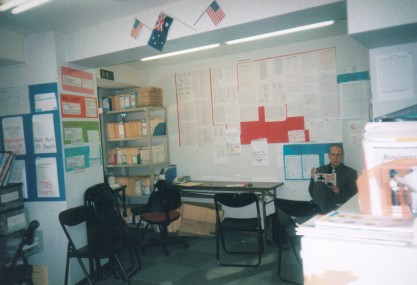
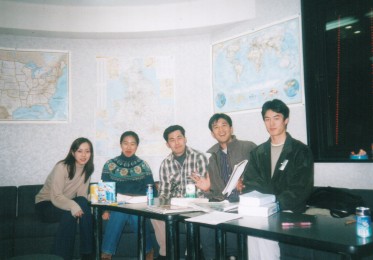
Most people working in Japan are probably teaching English. Why? The cash
is very good and depending on your level of interest, it can be easy or very
challenging, yet rewarding. Some companies will take just about anyone who can
speak fluently and wear a suit, others require qualifications. Either way,
teaching is a great way to get into the country, meet some people and have a
look around.
When you first start looking at teaching jobs, you will generally find them
listed as part or full time. The full time ones usually require a university
degree of any kind- this is a visa requirement and not necessarily relevant to teaching. If you
choose part time you can work for up to 18 months on a working holiday visa, but
you must be under 30 (check conditions for your own country as Australia and
Japan have special reciprocal working holiday agreements). It is certainly possible to survive working part time,
you just have to adjust your lifestyle. Often part timers can
pick up overtime though and make a reasonable living.
There are several companies to try, the most famous being NOVA, AEON, GEOS and
the JET program which is run by the Japanese government. A good general site which answers lots of questions is: http://www.teachinginjapan.com/
and my favourite www.bigdaikon.com which
is a JET site and has an interesting chat room and stories.
Companies have branches in many countries and recruit from overseas and in Japan. All have very different conditions so make sure you do your research and decide what is important to you. I got caught out assuming sick leave would be a set working condition, however it is not standard in some companies. Other things to check include health insurance, accommodation and transport, and whether you or your company will be paying for these.
The following insights are from my own experiences. Do not assume they are
the average experience as everyone I met and worked with had very different
experiences. Overall I had a wonderful time with both companies I worked for and
would certainly recommend either of them. I worked harder at NOVA than AEON but
NOVA was far more flexible. I hope the following information can help others
make more informed choices about what is important for them in their teaching
position.
| Recruitment | Visa |
| Schedule | Accommodation |
| Conditions | Transport |
| What is teaching like? | Sales, administration, counselling |
Both times I was recruited in my home city however the recruitment process varied greatly.
NOVA
I sent a resume via an agency at a university. I then was contacted, did a survey about my general knowledge of Japan (at the time practically zero) and was interviewed. The interview was about 30 minutes and I was asked questions about living away from home and my previous travel experiences. I was shown the textbook but teaching was barely touched on. I was offered the job and went to a one day optional seminar about living in Japan.
AEON
I sent a resume and essay directly to the branch office in my city. I was
contacted and asked to a group interview with 20 other people. It went from 9am
-7pm and covered information about Japan and teaching. All participants had to
give a lesson 10-15 minutes long. There was little instruction on the
content so people's lessons varied greatly in terms of difficulty and
appropriateness. Those who were considered to be viable applicants were invited
back the next day for a two hour individual interview in which we had to do both
adult and children's lesson presentations. At both stages we were given ample
opportunity to ask questions.
I was offered the position and a long process of contact with the recruiter and
my school began. I received letters of welcome from my school and was able to
contact other successful applicants.
NOVA
The work week is five days on, two off, with the days off chosen by the school. My days off were thursday and friday. My hours varied every day as there are three shifts: 10am-5.40pm, 11.40-7pm or 1.10-9pm. There is a 10 minute break between each class where the teacher is required to write comments on each student's performance and recommendations for improvement, as well as find the files for the next class and plan. The schedule was set but it was possible to change both the shift and days off depending on how busy the school was and how many teachers there were. At my main school there were about 25 teachers, full and part time. As there were no set classes, teachers were able to swap shifts in order to take extra days off. Saturday and sunday were popular days off, though teachers that had them had usually been working there several years or had religious or strong family reasons. Some teachers chose to work weekends and all evening shifts as outside 10am-5.40pm mon-fri penalty payments were available. If someone was sick their classes were taken by an overtime teacher. The ill teacher was not paid.
Part time and full time teachers were often given the chance to do overtime
and some teachers worked 12 hour days. I was also able to reduce my hours to 5
classes a day for a month before the Japanese Proficiency Test. In order to make
my weekend days early shifts I worked those days at a nearby school with only 2
teachers that had just started up.
All public holidays are worked except for new year. Teachers receive 5 other
days which must be requested a month beforehand.
AEON
The work week is either tues-sat or mon-fri with most teachers working tues-sat. The hours are set 12pm-9pm mon-fri with saturday 10am-7pm. I had to come in at 12pm once a week and 1pm the other days. The schedule was set and it was not possible to change until recontracting and there were no shift swaps. At my main school there were 5 foreign teachers, 2 full time Japanese teachers and about 6 part time Japanese teachers. There are no penalty payments.
Overtime was rare and emergency teachers not sent except for extended
absence. If teachers were sick others at the same school had to take over their
teaching load. This created the unhealthy environment of people coming to work
and spreading illnesses then taking longer than necessary to recover. No sick
leave was available, the teacher was either not paid or had to take leave from
annual leave. Management also promoted strong social pressure not to
be absent and made you feel like you had to beg to use your vacation leave as
others had to do your work when you were gone. I found this quite offensive as I
believe no one should be made to feel guilty about using owed leave. It was not
possible to reduce working hours or make any schedule changes.
All public holidays are given and Golden Week, Obon and New year are included.
For teachers with a tues-sat schedule there are days in July and November to
make up for lost public holidays falling on a monday.
| NOVA | AEON |
| Varying shift times and days on/off. Can do shift swaps, schedule hours can be reduced. | Set schedule, no options for days off, no shift swaps, no reduction in hours. |
| Starting salary of 24000yen for two months, then up to
300000yen/month depending on location/qualifications. Raise of 10000-20000 per month in subsequent years. Penalties/location allowance/teaching qualification allowances |
Set salary of 255000/month from the beginning, location
allowance in some cases. No penalties. Raise of 20000/month in second
year, 10000/month third year onwards. |
| Contract easily renewed, based on teaching observation test,
can be renewed one month before contract ends for one year but can leave
anytime |
Contract renewal through offer only, must be renewed six
months before expiry for a period of 3, 6 or 12 months |
| Turn over is very high, average stay 4-6months. Can stay on for as long as you can stand it! | Low turnover, average stay 1-1.5 years. Company would prefer up to two year stay after which they discourage recontracting. |
| No sick leave | No sick leave although annual leave can be used after the first two months |
| Five personal use days per year plus New Years holidays |
All public holidays, Obon, Golden Week, New Years, five personal use days. |
| Transport paid | Transport paid |
| Health insurance not paid, cost me 6000yen per month | Health insurance paid |
| No apartment subsidy, rent varied from 60000-90000yen/month. Can live in company or private apartment and not locked into company lease. Provided with basic furnishings. | Apartment subsidy, max rent 39000/month. Must live in
company apartment. Provided with extensive furnishings. |
| 3 days of training then regular assessment/observation/project work every few months and before recontracting | 1 week of training and 1 follow up day. Possible observation for recontracting. More if teaching children |
What is teaching like?
Teaching in Japan can mean many things and may end up only being part of your
job at a language school. There may be group general conversation, structured lessons, one-on-one or
children's classes. My youngest student was 2 years old, the oldest in their
70s. Find out beforehand
how many classes you are expected to teach, how much preparation is needed and
if you are even given preparation time, and
whether you will have administration or sales duties.
NOVA
Nova uses textbooks as a basis for their group lessons. The teacher is required in the 10 minutes between classes to choose a lesson suitable for all the students in the class (usually 1-4) and plan a role play and introduction. As students stay in the same level until the teachers feel they are ready to move up, some students may have done the same lesson numerous times. The challenge is then for the teacher to keep them interested in a lesson where they may have memorised the text's contents but not actually be able to use the grammar structures. The teacher is not actually supposed to explain grammar, rather present it using examples. I found this impractical and made great effort on my own to learn more about grammar and my lessons and confidence subsequently improved.
 |
 |
| NOVA teachers' room, a small cramped space shared by up to 25 teachers. On the walls are grammar explanations and student placement sheets. Around the outside of the room are filing cabinets with student records. | Voice room where free conversation classes
are held. Students are allowed to bring dictionaries, drinks etc. Seats up
to about 15 students though this would be an average class. |
Free conversation lessons are also held. Students buy tickets to enter the conversation lounge and may come in anytime and stay as long as their tickets last. There are no text books and the content is set by the students or the teacher. This can be particularly challenging for the teacher as students may be of any level of ability and confidence. I really enjoyed this class for the first few months as it gave me a chance to ask a lot of questions about Japan. Topics do wear thin though so after a while I started taking newspaper articles, games and pictures in to stimulate discussion.
Children's classes are either private or group depending on their age, not ability. When I started teaching children there were no materials or texts and I was basically an expensive babysitting service. Towards the end of my contract texts were introduced but no preparation time given. Unless the school was new, these classes were taught in a hallway or lobby causing great distraction to the child. The parents sometimes sat in on the classes.
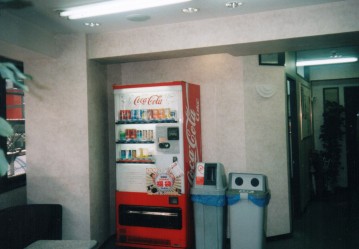 |
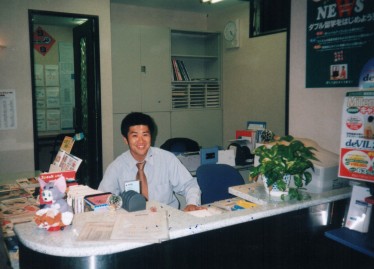 |
| Lobby area where students came before class and kids classes were held. Note vending machine, frequently used by parents to bribe kids into sitting still for at least part of the class. | Front reception, teachers'
room behind. |
Adult classes were taught in very small glass-walled rooms so the volume during peak time was great, making it difficult to hear each other even in the same room. Rooms changed every class. Although the noise was a problem I didn't mind this set up as it enabled me to see what other teachers did and exchange ideas. There were no whiteboards, tape players etc, the teacher only had scrap paper and pens which they had to supply themselves. Photocopying wasn't allowed or using any stationary/phones etc in the administration area.
Students chose their schedules at their convenience and were able to come as
many or few times a week as they liked. This meant I rarely saw the same
students and certainly never learnt most of their names. Students don't know
what lesson they will be doing before class and there is no homework or
preparation. It was difficult to monitor improvement and generally relationships
were not formed. Students and teachers were not allowed to socialise outside
school.
No class preparation time is given so for the first few months I did
outside work to learn the textbooks and supplementary materials. After three
months I had learnt all the lessons and was able to teach the same things over
and over.
All teachers are from overseas countries and teach all levels of English.
As a generalisation, both students and teachers were either really good or
really bad. Not many students were there to study hard; conversation, the chance
to speak with a foreigner and entertainment was the main objective. I really
felt like a dancing monkey at times when the same students did the same lessons
over and over. The ones I did see more than a few times did improve, their
grammar was very good and they were quite independent. After a while I was able
to conduct the class hardly talking myself, with the students contributing
heavily to the content and direction of the class. Students were generally very
good at free conversation. As for the staff, the teachers really varied, though
most had no previous experience with teaching and some had never even lived out
of home before, let alone a foreign country. Quality of teaching staff was
overall, not great. I had fun with the other teachers but didn't meet many
people who took teaching at all seriously. Japanese staff were administrators
only and most couldn't speak more than a few phrases of basic English.
AEON
AEON also uses textbooks as a basis for both their grammar based and function based lessons. Teachers are given time between classes to plan the lesson and make supplementary materials. The lessons are run on a four to six month rotating schedule so the same lesson may be taught several times in a week, then not again for four to six months. Students are assigned to a level as part of a contract and generally stay in that level until the contract expires. As a result some students were too good for the level and some really needed to repeat the level rather than move up but the teacher doesn't have much influence over this. The teacher isn't required to explain the grammar points as the students will have studied a set lesson prior to coming to class and have Japanese explanations in their texts.
There are no free conversation classes however teachers are required to talk to students in the lobby prior to classes.
Children's classes are taught at some schools but I was able to choose a school without children so I don't have much information on this.
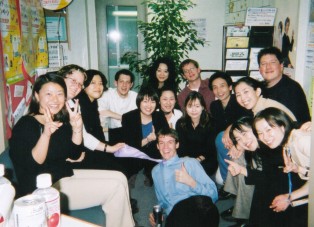 |
| The AEON lobby and staff. |
Classes were taught in separate classrooms with a whiteboard, tape/cd player, desk and shelves for the teacher. Teachers stayed in the same room and were able to decorate it. I did miss being able to see what others were doing but had greater control over my class.
Students had a set schedule and came at the same time every week. Teachers were required to learn their names and use them as much as possible. I thought this would be really difficult but was surprised how fast I was able to learn them. Students know what lesson they will be studying and have generally done homework to prepare. Teachers and students are encouraged to mix outside work and some did, however as we regularly saw each other and due to the cost of going out most people at my school didn't bother.
Plenty of preparation time is given and the school was very supportive during
my first few months when I was building up a supply of supplementary materials.
Some schools had materials made by previous teachers to share and each teacher
had their own materials. After teaching for six months I had a nearly complete
set and would have been able to reuse these.
Teachers from foreign countries generally teach only post beginner upwards.
Japanese teachers can be full or part time and take beginners to intermediate.
Generalising again, students and teachers were pretty good at AEON. Many
students do study hard and want to have a proper class and aren't interested in
just chatting. I was more able to give quality lessons and felt I was actually
making a difference to their education, not just entertaining them. I spoke much
more in class that at NOVA, I believe students actually need to listen to a
native speaker and not just each other. I found that while the students studied
hard in the context of their books, they were very dependent and lacked general
conversational skills. Many weren't good at free conversation and whilst able to
use the text, fell apart during free application. As for the staff, the teachers
again generally didn't have previous experience with teaching but had travelled
and were more capable as individuals. The average age was higher, mid to late
20s and 30s. The Japanese staff and teachers were lovely and all worked very
hard and were always willing to help. Nearly all could speak at least some
English and were happy also to speak with me in Japanese.
At the time I went with NOVA only one year visas were offered. Several rules have changed recently and now three year visas are offered. The important thing to remember with visas is that the company is only the sponsor, it doesn't own your visa. Once the visa is issued you are able to leave your company and work elsewhere, then get that company to sponsor you.
Previously people on working holiday visas could work part time and had to leave the country to change to working visas, now this can be done in Japan. NOVA has tightened its rules for working holidays visas in the last year.
It is very easy to get a spouse visa via the Japanese consulate in your home city, once one person has a working visa. This need not have anything to do with your company. Make sure you check the rules with the Japanese embassy or consulate, do not simply believe your company-they don't always have your best interests in mind!
NOVA
When I arrived I was met at the airport and driven to my apartment. The apartment was two stations away from my school and in a block with 8 other foreign teachers from Australia and the US. I was provided with basic facilities, a futon, fridge, shelves, TV and washing machine. Rent was 60000yen/month and I signed a month to month rental contract. I had trouble getting minor problems fixed, the landlord (who was Austrian and specialised in foreign rentals) preferred me to do it myself and take any costs out of the rent the next month. Rent was paid monthly in cash into a bank account set up by the landlord. I enjoyed living in a group environment and it really helped with adjusting to my new home.
After 5 months I moved in with another teacher to a private apartment and I was able to walk to school. I was not on the lease but had no problems.
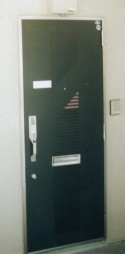 |
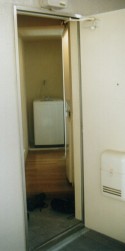 |
| The front door to my apartment, more like a jail cell! | Looking inside, at the end of the corridor is the washing machine, to the right the hotplate, sink and bathroom. |
AEON
I was met at the airport and spent a week in a training facility with 20
other teachers, then spent another week in a hotel while the teacher I was
replacing moved out. My apartment was 25 minutes by train to my school with a 20
minute walk to the station. I was supplied with a range of furniture right down
to cutlery and cleaning products.
I saw my landlords daily as they ran a bike shop and lived on the ground floor.
They were very helpful in fixing small problems and generally friendly once they
knew I could speak Japanese. I never saw anyone else in the whole apartment
building and found the experience isolating. Rent was taken out of my salary
every month.
AEON requires you to live in their housing, you can leave but you will still be charged rent for the apartment which effectively locks you in. They are very inflexible with changing apartments and housing rigidity was the reason I left this company.
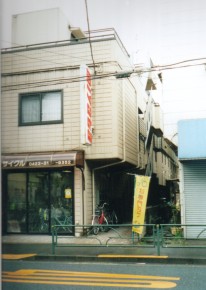 |
 |
| My room was in a two story building above a bike shop. The landlords ran the shop and lived behind it on the ground floor. | My room and furnishings, the whole apartment was the size of my current lounge room. |
Paid for in both cases by the company. I had a monthly ticket between my home and work stations. This was great as it saved me money on weekends as well. (A naughty trick-on return trips buy the cheapest ticket and insert your monthly at your home station)
Sales, administration, counselling
NOVA
I had to do level checks and demo lessons for prospective students. The school preferred to chose whoever was the most blonde and foreign looking as that was what the students went for. Demo lessons were taught to a structure and as I taught all levels and knew the texts well I was easily able to judge levels. Once the students had signed up there was no ongoing support.
AEON
Mostly interviews for prospective and renewing students, there were set demo lessons but usually I just chatted. I didn't teach lower levels so was only able to judge the level of those at least above post beginner. Counselling sessions were held for ongoing students and there was a lot of support. In sales sessions staff were usually matched male-female and I was encouraged to wear lipstick!
 Japan index |
 Home |